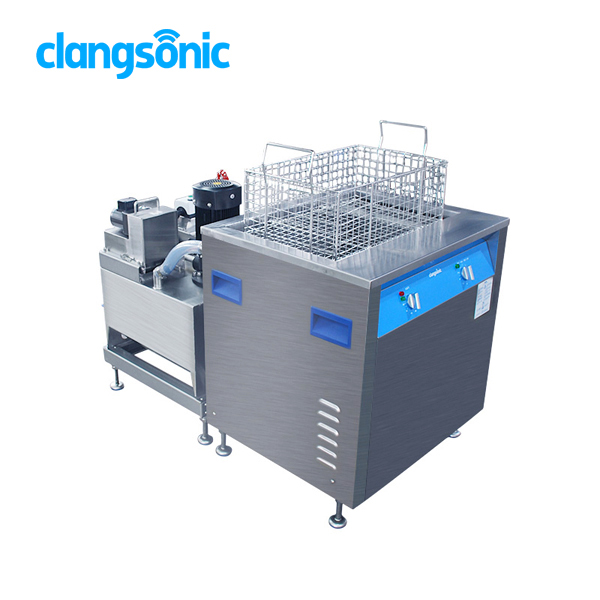How do Ultrasonic Cleaners Provide Efficient, Safe Cleaning Solutions Across Industrial, Medical, Jewelry, and Household Sectors?
2025-09-26
As industries raise their requirements for cleaning precision and efficiency, the drawbacks of traditional manual cleaning—such as being "prone to leaving blind spots and damaging materials"—have become increasingly prominent. Leveraging the capability of "generating cavitation effect via high-frequency vibration to achieve non-contact deep cleaning," ultrasonic cleaning machines have been widely applied in industries including industrial manufacturing, healthcare, jewelry, and household, providing efficient and safe cleaning solutions for diverse scenarios.

1. Industrial Precision Parts Sector: Overcoming Cleaning Challenges of Complex Structures
In industrial scenarios with auto parts, electronic components, and mechanical hardware, precision parts often have oil stains, metal shavings, and other residues stuck in gaps, blind holes, and threads. These areas are hard for traditional cleaning methods to reach. Ultrasonic cleaning machines use high-frequency cavitation to enable cleaning fluid to penetrate tiny gaps and quickly strip away dirt:
For auto parts like engine fuel injectors and bearings, they can remove internal oil deposits and carbon buildup, preventing equipment failures caused by incomplete cleaning;
When cleaning chips and circuit boards in the electronics industry, they can be paired with neutral cleaning solutions to remove solder residues and dust without scratching or damaging components, ensuring the conductive performance of electronic parts and meeting the large-scale, high-precision cleaning needs of the industry.
2. Medical Device Sector: Balancing Cleaning Efficacy and Sterilization Safety
The healthcare sector has strict requirements for "sterility and non-damage" when cleaning instruments. So ultrasonic cleaners have become the preferred choice for cleaning dental instruments, surgical tools, and laboratory glassware:
For small medical tools like dental handpieces and forceps, ultrasonic vibration can remove blood stains and tissue residues from tooth grooves and joints. After that, high-temperature sterilization makes sure they meet medical sterility standards;
For laboratory glassware like test tubes and pipettes, ultrasonic cleaning avoids scratches on the inner walls caused by manual scrubbing. It also thoroughly removes reagent residues to make sure experimental data is accurate – this fits safety rules in the medical field.
3. Jewelry and Watch Sector: Restoring Luster While Protecting Materials
Jewelry, watches, and similar accessories tend to accumulate sweat and dust during wear, with dirt trapped in gaps that are hard to clean. Manual wiping also risks scratching their surfaces. Ultrasonic cleaners achieve "gentle cleaning + luster restoration":
When cleaning diamond, gold, and K-gold jewelry, there is no need for strong acid or alkaline cleaners—only water or neutral detergents are required to strip away dirt from gaps, restoring the accessories’ original luster;
For watch cases and straps (excluding electronic components) of mechanical watches, they can remove dust and oil from strap gaps, eliminating the hassle of manual disassembly for cleaning while protecting the watch’s metal plating from damage.
4. Household Daily Use Sector: Simplifying Cleaning of Small Items
In household scenarios, small items like glasses, razor heads, and tableware need to be cleaned often, and ultrasonic cleaners make this process easier:
Fingerprints and oil stains on eyeglass lenses can be cleaned in 3–5 minutes with ultrasonic vibration. You don’t need to wipe them over and over with a lens cloth—and this avoids scratches;
They quickly remove beard residues from razor heads and oil stains in tableware gaps. This is great for busy people, because they make daily cleaning more efficient and you don’t need to watch them while they work.
| Application Sector | Core Cleaning Objects | Cleaning Advantages | Industry Pain Points Addressed |
|---|---|---|---|
| Industrial Precision Parts | Auto parts, electronic components | Penetrates gaps, non-damaging, large-scale cleaning | Incomplete cleaning of complex structures, easy part damage |
| Medical Devices | Dental instruments, laboratory glassware | Sterile, residue-free, meets medical standards | Manual cleaning fails to achieve sterility, easy scratching |
| Jewelry and Watches | Diamond/metal jewelry, watch components | Gentle cleaning, restores luster | Hard-to-clean gap dirt, easy surface scratching |
| Household Daily Use | Glasses, razor heads, tableware | Easy operation, time-saving | Tedious manual cleaning, prone to blind spots |
Now, ultrasonic cleaners are changing toward "scenario-specific customization": Industrial models have cleaning tank designs that fit parts of different sizes; household models have small portable versions; and medical models add drying and sterilization functions. As a key piece of equipment for efficient cleaning, using them widely in many industries will keep making cleaning processes change toward "more precision, safety, and efficiency."




